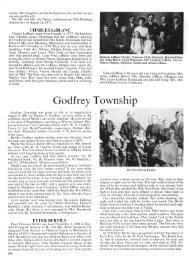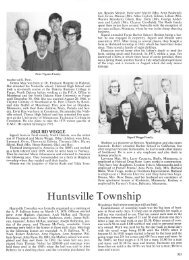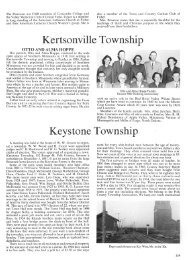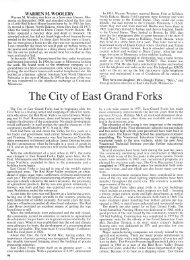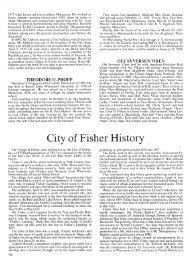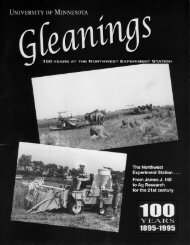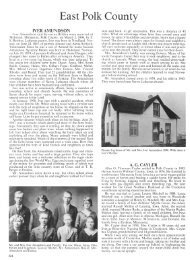Bicentennial history of Polk County, Minnesota - to files - University ...
Bicentennial history of Polk County, Minnesota - to files - University ...
Bicentennial history of Polk County, Minnesota - to files - University ...
Create successful ePaper yourself
Turn your PDF publications into a flip-book with our unique Google optimized e-Paper software.
Dakota. There he worked for Martin Nettum. They movedback <strong>to</strong> Neilsville in 1931 <strong>to</strong> the former McLain Brothers farmin Hubbard <strong>to</strong>wnship and have lived there ever since.In April 1975 they celebrated their golden wedding anniversary.Both have been active members <strong>of</strong> the St. Petri LutheranChurch. Ingeman served as trustee for many years, also as deaconand treasurer <strong>of</strong> the A.L.C. He was a member on theschool board <strong>of</strong> District 17. They have three children, Margaret,Karl and arley, four grandsons and three great grandchildren.Inga and Ingeman, <strong>to</strong>gether with their son Karl and hisfamily, flew <strong>to</strong> Norway for a visit with relatives and for sightseeingin July, 1975.The Ingeman Jevning Family : Standing, L. <strong>to</strong> R.: Karl, Margaret andOrly. Seated: Inga and Ingeman.Margaret graduated from Climax High School, was a medicaltechnician at St. John's Hospital in Fargo for two years,attended the <strong>University</strong> <strong>of</strong> Moscow, Idaho, enlisted in theWAVES and served two years in the Medical Corps at theNaval Hospital Bethesda, Maryland. In 1948 she married RaymondHayes and they are now living in Miami, Florida. Theyhave three sons, Randy, David, both married and are landsurveyors in Ft. Meyers, Florida; and John works in Miami.Karl, a graduate <strong>of</strong> high school, served four years in theUnited States Air Force, 1951-55. He works for Reserve MiningCompany, in Silver Bay and is a foreman in the pelletizingdepartment. He married Frances Crumely from Tennessee,they have one son. Steven, a student <strong>of</strong> Bemidji State <strong>University</strong>.Orley graduated from Climax High School and is a farmer.He rents 550 acres and is an active member <strong>of</strong> the St. PetriLutheran Church, having held several <strong>of</strong>fices, including president,vice president, secretary, trustee and memorial secretary;also A.L.C.M . <strong>of</strong>fices several times. He is secretary-treasurerfor the Nielsville Flying Club. and holds other communityjobs. He lives at home.PETER JOHNSONPeter Johnson was born in luteland, Denmark, Oc<strong>to</strong>ber 9,1861. Together with his parents, brothers and sisters, he immigrated<strong>to</strong> the United States in 1892. They settled in the St.Croix Falls, Wisconsin area, where he worked for some time.In 1893, he came <strong>to</strong> the Red River Valley and homesteaded ona quarter <strong>of</strong> land east and south <strong>of</strong> Nielsville, where his brotherSam was living. Sam died some time after that. Peter rentedthree quarters <strong>of</strong> land from his brother-in-law, H. K. Hanson<strong>of</strong> Stillwater, who had land out there. Emil Casperson workedfor him for one year and received $200.Peter returned <strong>to</strong> St. Croix Falls, Wisconsin and marriedSina Andersen. She was born near Juteland, Denmark, andhad immigrated with her family <strong>to</strong> the St. Croix Falls area.They were married February 20. 1894 and came out <strong>to</strong> Nielsville<strong>to</strong> live. They came by train <strong>to</strong> Beltrami and the ride homewas by lumber wagon, not a pleasant ride for a young bridewho had been working in St. Paul. On April II , 1898, PeterJohnson applied and was admitted <strong>to</strong> become a citizen <strong>of</strong> theUnited States. He was active in community affairs and servedon the <strong>to</strong>wn board and school board for some years. The Johnsonsgot their ma il at the Kalmer post <strong>of</strong>fice near Shelly andbelonged <strong>to</strong> the Zion Lutheran Church.Six children were born <strong>to</strong> them : Lillias, who married Ot<strong>to</strong>Eidsmoe, had three children; Shirley, Margarett, and Arrin.William, who married Clara Hauge n, had one son, Robert.Mildred. who married William Hetland, had four children:Barbara. Wayne, Eldon, and Janice. Palmer went <strong>to</strong> Pontiac,Michigan where he died suddenly January I, 1942. Earl marriedAlice Opperud and had four children: Bruce, Sonia, Bria nand Brent. Earl died Oc<strong>to</strong>ber 18. 1970 at Jacobsen, <strong>Minnesota</strong>.Evelyn married Alfred Hetland and had two children: Dennis,who has died, and JoAnn. Evelyn died June 28, 1967.In 1900, after living in a small house. Peter and Sina Johnsonwere ready <strong>to</strong> move in<strong>to</strong> a nice big house they had justcompleted building, when a big hail s<strong>to</strong>rm struck a nd broke allthe windows and made big dents in siding and destroyed thegrain fields. In farming a section <strong>of</strong> land with horse machinery,it <strong>to</strong>ok a great many horses and a big horse barn. They had 20nice horses. One year the horses got sick with what they calledswamp fever and 10 or 12 horses died. They used binders <strong>to</strong>cut the grain and the grain had <strong>to</strong> be shocked; so men wouldcome out from the cities <strong>to</strong> work through the harvest andthreshing season. During the threshing season the farmers had<strong>to</strong> feed all the men. They were always well fed with c<strong>of</strong>fee,cake, sandwiches, cookies or doughnuts for lunch, and for dinnersthere were a few kinds <strong>of</strong> meats. pota<strong>to</strong>es, lots <strong>of</strong> vegetables,bread, salads and always pies. So the women really had alot <strong>of</strong> work <strong>to</strong> do <strong>to</strong> feed all those men during harvest. The menreceived about $1 a day and $1.50 during threshing.It was over two miles <strong>to</strong> walk <strong>to</strong> a one-room school. Theteacher had <strong>to</strong> come early in the morning <strong>to</strong> get the s<strong>to</strong>vestarted in the winter. School was about six months a year, withtwo weeks <strong>of</strong> Norwegian Parochial School. Foot heaters had <strong>to</strong>be used <strong>to</strong> keep the children's feet warm against the bitter cold.Gradually the farmers started buying trac<strong>to</strong>rs, swathers, andcombines, so not so much help is needed <strong>to</strong> do the farm work.Times have changed very much since those early days in theRed River Valley.Peter Johnson died at the age <strong>of</strong> 71 years and his wife Sinawas 80 years old when she passed away.MR. AND MRS. BJORN LANAGERBjorn Lanager and Ronoag Halvorson were married inNess, Norway in 1862. Three children were born there: Elling,Halvor, and Jessie. They emigrated <strong>to</strong> America in 1872. Thejourney was a long, hard one lasting eight weeks.They came <strong>to</strong> Spring Grove, <strong>Minnesota</strong> in Hous<strong>to</strong>n countyand it was there their youngest child Julia was born, July 29,1873 . They lived two years in the <strong>to</strong>wn <strong>of</strong> Spring Grove andone year on Ole Berg's farm. Then the family moved <strong>to</strong> TwinValley. where Bjorn worked for Jens Aurdahl. He moved fromthere <strong>to</strong> Gary, <strong>Minnesota</strong>, where he homesteaded. Later hebought a quarter section <strong>of</strong> railroad land; this was in the <strong>to</strong>wn<strong>of</strong> Strand. At that time, as soon as the land was surveyed bythe government, immigrants began <strong>to</strong> drift northward and settlerscame from southern <strong>Minnesota</strong> in quest <strong>of</strong> free land. Inthe years 1879 and 1880 almost all the homestead sectionswere taken up. Only railroad land remained, which could bebought for $2.50 per acre and at some places for less.The first <strong>to</strong>wn meeting in Town <strong>of</strong> Strand in the county <strong>of</strong><strong>Polk</strong>, state <strong>of</strong> <strong>Minnesota</strong>, was held at the residence <strong>of</strong> Bjorn E.Lanager. on the thirteenth day <strong>of</strong> March, 1880. The meetingwas called <strong>to</strong> order by Bjorn E. Lanager, Town Clerk.At first school was held in the homes. Then a log schoolhousewas built which had homemade sloping desks, a homemadestand for the teacher, and a large box s<strong>to</strong>ve <strong>to</strong> keep itwarm. There were up <strong>to</strong> 38 pupils in their school. Bjorn Lanagerwas a leader in building the first school and first church.The Lanagers started out with two cows, one a ll brown bellcowcalled Redling and another white and brown called Culta.Their first team was a pair <strong>of</strong> dark brown mares which Bjorn319





